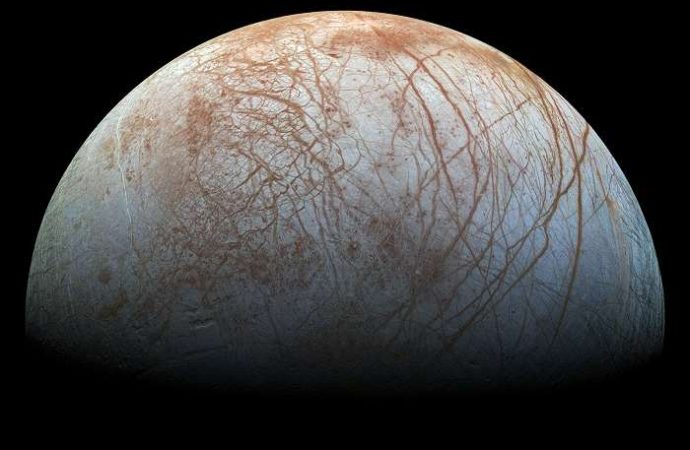Using the Hubble Space Telescope (HST), astronomers have spotted an atomic hydrogen corona around Jupiter’s icy moon Europa.
The discovery which could improve our understanding of Europa’s tenuous atmosphere was published Jan. 13 in the Astronomical Journal.
Europa has a thin atmosphere composed mostly of molecular oxygen which is generated from sputtering and radiolysis of the moon’s surface ice by impacting magnetospheric ions. While molecular oxygen is the densest component of Europa’s atmosphere, the surface sputtering also produces water and molecular hydrogen at similar rates to molecular oxygen. However, it is known that only the noncondensable molecular oxygen builds up a near-surface bound atmosphere, while the other sputtering products like water freeze upon surface contact or quickly escape the moon’s gravity—which is the case with molecular hydrogen.
In order to reveal more insights on the nature of Europa’s atmosphere, a team of astronomers led by Lorenz Roth of KTH Royal Institute of Technology in Stockholm, Sweden, observed this moon in ultraviolet light with HST between December 2014 and March 2015. Due to the fact that most of the ultraviolet light gets absorbed in the atmosphere, such observations are not possible with ground-based telescopes and must be carried out by space observatories like Hubble.
The far-ultraviolet observational campaign utilizing HST allowed them to obtain images of Europa during its six transits of Jupiter and was focused on detecting localized signals from water vapor. However, the results of these observations turned out to be even more promising than expected.
“The main goal of the observing campaign was actually finding localized signals from water vapor in the ultraviolet hydrogen emission. Ye we found a widely extended and homogeneous cloud of hydrogen around Europa,” Lorenz told Phys.org.
The new research confirms the abundance of hydrogen in Europa’s global atmosphere that was predicted in previous studies. In particular, the scientist’s analyzed the images constraining atmospheric absorption of Jupiter’s Lyman-alpha dayglow above the limb of Europa during the transit. They managed to constrain the abundances of atomic hydrogen in the moon’s extended corona and derive upper limits for local water vapor abundances from plume activity.
“The amount of hydrogen we observed was actually expected to exist and ultimately originates from the erosion of Europa water ice surface,” Lorenz said.
Although the researchers derived the global abundance of hydrogen, they cannot yet confirm whether the hydrogen corona changes with time or location. They suggest that an uncertainty of about 20 percent of the derived coronal hydrogen density is based on the differences in the fitted spatial profile of the background dayglow.
“The fitted densities for the six visits vary by about 20 percent around the average of 1.85×103 cm−3 and the variation exceeds the obtained uncertainties, suggesting an intrinsic variability of the hydrogen corona. We have searched for possible connections of the density variability to changes in either the magnetospheric environment or the orbital true anomaly, but do not find an apparent correlation,” the team concluded.
Source: Phys.org

































Leave a Comment
You must be logged in to post a comment.